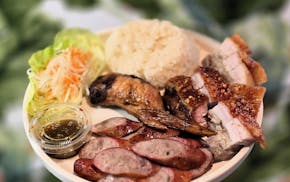Experiences, like fine wine, can get better with age.
That's why it took author George Sorensen decades before he wrote his fifth book, "Hot Dish Confidential: That Year My Friends Taught Me to Cook," which chronicles his journey from campfire cook to gourmet chef, all in a year's time.
"Often when you have an experience, it takes a while to digest it and think about it," said Sorensen, who spent years in the Twin Cities before moving to Oregon. "So it took a while to get old enough, to get some perspective. And the world of cooking has just gotten more interesting as years have gone by."
Up to that point, Sorensen's cooking experience had been gleaned from monthly Boy Scout camping trips. "My parents hardly ate vegetables, and when they did they were canned," he said. "And they were usually something like string beans that everybody hated, and then they would boil them for days and insist you eat it because it's good for you."
While living in Minneapolis, where he worked in corporate communications, Sorensen was inspired by Peter Mayle's 1989 book "A Year in Provence" to recruit culinary-minded friends for monthly dinners. Each one featured a different cuisine in an effort to, as he writes, "finally learn my way around the kitchen."
The book is filled with delicious anecdotes, fact-finding missions, morel hunting tales, lessons in wine collecting and recipes from each month's dinners. There were soufflés, quiches, rattlesnake sour cream enchiladas and tunic (not toga) parties. And there were plenty of other adventures, culinary and otherwise. A backyard neighbor taught him about herbs, trips to mushroom and chestnut farms gave him encyclopedic knowledge of both, and along the way he met his future wife, with whom he conquered and perfected the art of preserving apricots. (Their debut apricot jam won a blue ribbon at the Minnesota State Fair.)
He still keeps up with members of the Sorensen Gourmet Dinners group, and several will be at his upcoming Twin Cities book events. We caught up with Sorensen ahead of his visit and talked about his famous college classmates, the dinner that prompted a call to poison control and that State Fair blue ribbon. The interview has been edited for length and clarity.
Q: You were very methodical in planning the dinners in your book. Do you have a research background?
A: My major in college was theater arts, and there isn't an awful lot of research to be done. One of my [San Diego State University] classmates in theater was Julie Kavner, who's the voice of Marge Simpson. And another classmate for a year was Carl Weathers, who just passed away, and he was in the "Rocky" movies.
Q: Oh, wow. But from theater to research?
A: Yes, I have quite a lot of experience with it. I was on the launch team for Post-it notes at 3M and worked with NASA in the Mars program at the Jet Propulsion Laboratory and wrote documentation for them. I also did marketing communications that isn't quite so technical. ... But all the time I was working on books, working on my own writing.
Q: Have you always been writing?
A: Yes, that's always been my major interest. I wrote about 250 industrial videos for 3M alone. I mean, they're not that hard to write, but you've got to earn a living. And the advantage to working in the corporate environment is the deadlines aren't as tight and your byline is not on anything. People have read things I've written, they just didn't know they did.
Q: Is it difficult to separate the corporate from the creative writing?
A: The writing you're doing for yourself uses similar skills, but you need to do the stuff that pays first. So this is always the dilemma that a writer faces, since writing doesn't necessarily pay all that well. So what do I do in the meantime? Most artists, writers, actors — anyone in a creative field — find a regular source of income while they're building their own writing. The first two books I wrote were about how to write in the corporate environment.
Q: Back to this book, as you look back on the dinners, does one stand out?
A: I think the clambake that we did in a trash can in this guy's driveway stood out to me as being the most adventurous because I called up poison control. And I said, "Is this gonna kill everybody at the party?" You don't want to have a bunch of ambulances pulling up just before dessert is served.
Q: What emerged as your favorite culinary technique?
A: The difference between cooking hot and slow and how to handle them. Learning to cook slow is a little easier because if you make a mistake, you have more time to correct it. But if you're cooking fast, like you're sautéing a piece of salmon and you can only put it on the hot plate for 3 minutes a side. Well, you only have 6 minutes to either succeed or fail at that. It takes practice to learn to work with higher temperatures.
Q: How did the experience change your cooking philosophy?
A: Now I better understand why people default to cooking things like hamburgers, because there's just nothing to it. But there's other things you can cook that are a little more involved, and approaching things that you're unfamiliar with is essential because then you learn how to prepare them. And just to understand that if it's a weekend and you say "I don't feel like going to the store, what do I have in the house that I can turn into something? And then what do I want it to turn into?" So that's probably the thing I learned the most, is how to just make do with what I have and make it interesting.
Q: What's your favorite ingredient?
A: Wow. You know, I think carrots. There's so many things you can do, and they last a long time in the refrigerator. And even if you leave them in the refrigerator too long, and they kind of get noodley, no one knows that after you cook them. The way I like to cook them is if they're particularly thick, cut them long way. You can either peel them or not, and then just sauté them over low heat in a high-quality pan and they will gradually caramelize the outside. You can eat them hot or cold and they can sit there in the pan for hours. And you can serve them and they're great. So I'd say the old, lowly carrot.
Q: After your State Fair-winning debut, do you still make jelly and jam?
A: Well, occasionally we do after our great success. All of a sudden these two children arrived in the blink of an eye. And you know how much time they take? And so sometimes it's just easier to go find the jar of jam you like at the store. But we still have all the equipment, so sometimes we'll just go, "Wow, look at all the peaches or look at all the apricot." You know, we do have this association with apricot that we will never get rid of.
Q: How do you go from blue ribbon winner to anything else? I mean, the pressure is on.
A: Oh, it's all downhill. But what a solid foundation for a marriage, right? This happened just three months after we met — that was pretty quick. And I remember picking up the ribbon at the end of the fair. There was a big long line of people lining up to get their ribbons, and I walked down the line going, "Hey, look, look! I won the blue ribbon!" and people started to applaud. It was hilarious.
Meet the author
Author George Sorensen is in town next week for three events tied to Tuesday's debut of his book, "Hot Dish Confidential" (Flexible Press, $19).
April 1: Book signing from 1-2 p.m., Boréal Gifts & Goods, 2276 Como Av., St. Paul, shop.boreal.life.
April 2: A free and public launch party, 7 p.m., Broken Clock Brewing Cooperative, 1712 NE. Marshall St., Mpls., brokenclockbrew.com.
April 3: Reading, 6:30 p.m., at Comma bookshop, 4250 Upton Av. S., Mpls., commabookshop.com.
Worth noting: A portion of the proceeds from "Hot Dish Confidential" goes to Second Harvest Heartland, which helped provide 128 million meals last year in Minnesota and western Wisconsin.
Jay's Wild Rice Clam Chowder
Serves 8.
This recipe is from the author's ocean-themed dinner party. From "Hot Dish Confidential," by George Sorensen (Flexible, 2024).
• 6 medium potatoes, peeled and cut into 1/2-in. cubes
• 2 (32-oz.) boxes of unsalted chicken broth, divided
• 2 (6.5-oz.) cans minced clams, drained with liquid reserved
• Juice of 1/2 lemon
• 3 bay leaves
• 1 c. uncooked wild rice
• 1/4 diced bacon
• 1 1/2 medium onions, finely chopped
• 6 tbsp. flour
• 1/2 lb. mushrooms, thickly sliced
• 3 tbsp. butter
• 1 1/2 c. whipping cream
• 1/4 c. dry sherry
Directions
In a 6-quart stockpot, combine clam liquid, 1 box of chicken broth, potatoes, lemon juice and bay leaves. Bring to a boil. Reduce heat and simmer for 20 minutes.
Meanwhile, cook the wild rice in 3 cups of chicken broth for 30 minutes. Drain the rice, if all the liquid wasn't absorbed, and set aside.
Cooked diced bacon over a low heat so it doesn't get too crispy. Drain the bacon, reserving half of the drippings in the pan.
To the bacon drippings, add the onions, mushrooms and butter and sauté until the onions are translucent. Add 6 tablespoons of flour to the onion mixture; cook and stir to thicken.
To the pot of potatoes, add the bacon, cooked wild rice, clams and onion-mushroom mixture. Stir in whipping cream and sherry. Heat through while stirring. Serve with a few oyster crackers on top.

Critics' picks: The 11 best things to hear, do and see in the Twin Cities this week

Critics' picks: The 9 best things to do and see in the Twin Cities this week

The 5 best things our food writers ate this week

The 5 best things our food writers ate this week


